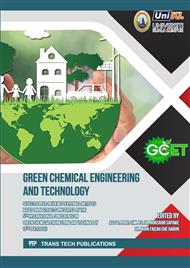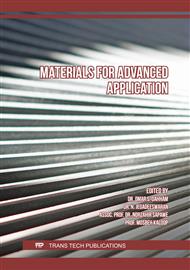[1]
F. Farhan, R. Pratama, D. Maulana, and G. Fitriyano: Nat. Sem. Scie. and Tech., Jakarta, 2017, p- ISSN : 2407 – 1846, e-ISSN: 2460 – 8416.
Google Scholar
[2]
J. Yu, D. Zhang, S. Zhu, P. Chen, G.-T. Zhu, X. Jianga, and S. Di: Eco-friendly and facile one-step synthesis of a three dimentional net-like magnetic mesoporous carbon derived from wastepaper as a renewable adsorbent, 2019, 12419-12427.
DOI: 10.1039/c9ra01332f
Google Scholar
[3]
Z. Dengfeng, D. Li, A. Li, M. Qi, D. Cui, H. Wang, and H. Wei, Activated carbons prepared via reflux-microwave-assisted activation approach with high adsorption capability for methylene blue, J. Env. Chem. Eng., 2020. Reference to: JECE 104671. https://doi.org/10.1016/j.jece.2020.104671.
DOI: 10.1016/j.jece.2020.104671
Google Scholar
[4]
T. Xiaodong, G. Ran, J. Li, Z. Zhang, and C. Xiang, Extremely efficient and rapidly adsorb methylene blue using porous asorbent prepared from waste paper: Kinetics and equilibrium studies. College of Chemistry and Chemical Engineering, Southwest Petroleum University, Chengdu, 610500, PR China. (2021). https://doi.org/10.1016/j.jhazmat.2020.123579.
DOI: 10.1016/j.jhazmat.2020.123579
Google Scholar
[5]
T. Huda and T.K. Yulitaningtyas, Methylene blue adsorption study using cellulose from alang-alang, Universitas Islam Indonesia. Vol. 01, No 01, 2018, pp.09-19. ISSN 2622-7401, e ISSN 2622-7126.
DOI: 10.20885/ijca.vol1.iss1.art2
Google Scholar
[6]
W. Hu, S. Cheng, H. Xia, L. Zhang, X. Jiang, Q. Zhang and Q. Chen, Waste phenolic resin derived activated carbon by microwave-assisted koh activation and application to dye wastewater treatment. Green Processing and Synth. 8 (2019) 408-415. https://doi.org/10.1515/gps-2019-0008.
DOI: 10.1515/gps-2019-0008
Google Scholar
[7]
M.E. Mahmoud, M.S. Abdelwahab, Fabricated and functionalized magnetite/ phenylenediamine/cellulose acetate nanocomposite for adsorptive removal of methylene blue. Int. J. Biol. Macromol. 128 (2019) 196–203. https://doi.org/10.1016/j.ijbiomac.2019.01.102.
DOI: 10.1016/j.ijbiomac.2019.01.102
Google Scholar
[8]
F. Mbarki, T. Selmi, A. Kesraoui, M. Seffen, P. Gadonneix, A. Celzard, V. Fierro, Hydrothermal pre-treatment, an efficient tool to improve activated carbon performances. Ind. Crops Prod. 140 (2019) 111717. https://doi.org/10.1016/j.indcrop.2019.111717.
DOI: 10.1016/j.indcrop.2019.111717
Google Scholar
[9]
M.A. Franciski, E.C. Peres, M. Godinho, D. Perondi, E.L. Foletto, G.C. Collazzo, G.L. Dotto, Development of CO2 activated biochar from solid wastes of a beer industry and its application for methylene blue adsorption. Waste Manage. 78 (2018) 630-638. https://doi.org/10.1016/j.wasman. 2018.06.040.
DOI: 10.1016/j.wasman.2018.06.040
Google Scholar
[10]
A. D. Karisma, T. Hamaba, T. Fukasawa, A. N. Huang, T. Segawa, and K. Fukui, Validation of measured microwave absorption and temperature change for development of a single-mode-type microwave heating thermogravimetry apparatus, 2017, vol. 88, no. 2.
DOI: 10.1063/1.4974813
Google Scholar
[11]
A. D. Karisma, Y. Shinokawa, T. Fukasawa, and T. Ishigami, Synthesis of NiCuZn ferrite nanoparticles from metallic nitrate solutions using the microwave direct denitration method and evaluation of its properties, Part. Sci. Technol., 2020, vol. 0, no. 0, p.1–9.
DOI: 10.1080/02726351.2020.1748148
Google Scholar
[12]
Arnelli, U.H.H. Putri, F.N. Cholis, and Y. Astuti, Use of microwave radiation for activating carbon from rice husk using ZnCl2 activator. Chem. Dept., Fac. Sci. Math., Diponegoro University, Tembalang, Semarang 50275, Indonesia, 2019, 283-291. ISSN:1410-8917, e-ISSN: 2597-9914.
DOI: 10.14710/jksa.22.6.283-291
Google Scholar
[13]
S.S. Lam, R.K. Liew, Y.M. Wong, P.N.Y. Yek, Microwave-assisted pyrolysis with chemical activation, an innovative method to convert orange peel into activated carbon with improved properties. J. Ckeaner Prod. 162 (2017) 1376-1387.
DOI: 10.1016/j.jclepro.2017.06.131
Google Scholar
[14]
B.A. Ikhtiar and G.P. Lobo, Characterization of active carbon prepared from coconuts shells using FTIR, XRD, and SEM techniques, 2018, P-ISSN: 2303-1832, e-ISSN: 2503-023X.
DOI: 10.24042/jipfalbiruni.v7i1.2459
Google Scholar
[15]
H. Lilik, E. Yulianti, and R. Mahmudah, Characterization of NaCl activated carbon from tofu dregs, UIN Maulana Malik Ibrahim Malang, 2012, Vol 23.
Google Scholar
[16]
M. Manuntun, O. Ratnayani, and R.A. Prawira, Synthesis and characterization of charcoal from bamboo waste with ZnCl2 activator, Chem., Fac. Math. and Nat. Sci., Udayana University, Bali 80361, Indonesia, 2018, Volume 7 Number 1, ISSN 2302-7274.
Google Scholar
[17]
Osvaldo Pezoti Junior, A.L. Cazetta, R.C. Gomes, E.O. Barizao, I.P.A.F. Souza, A.C. Martins, T. Asefa, and V.C. Almeida, Synthesis of ZnCl2-activated carbon from macadamia nut endocarp (Macadamia integrifolia) by microwave-assisted pyrolysis: Optimization using RSM and methylene blue adsorption, J. Anal. App. Pyrol. 105 (2014) 166–176. http://dx.doi.org/10.1016/j.jaap. 2013.10.015.
DOI: 10.1016/j.jaap.2013.10.015
Google Scholar



